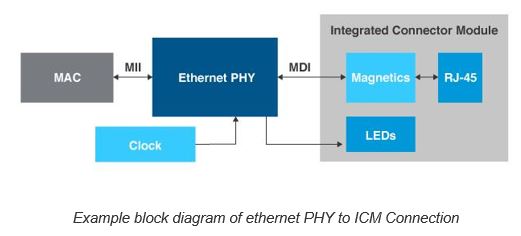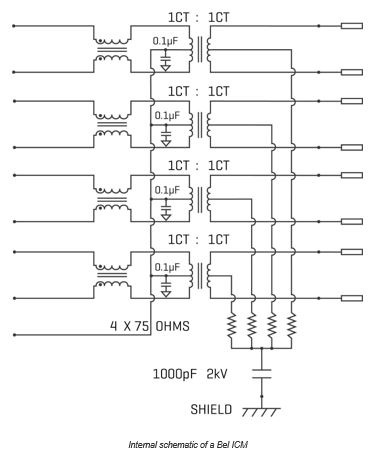NBASE-T and Integrated Connector Modules Speed Up Networks
The NBASE-T standard was devised to create lower-cost upgrade paths to boost network performance, achieve multigigabit speeds, while using CAT 5 and CAT 6 cabling already in place.

There has always been an imperative to move data more rapidly, to simultaneously reduce the amount of time waiting for data and to handle the increasing amount of data being transferred. The total volume of annual network traffic, now measured in exabytes, is rapidly accelerating toward zettabytes.
The relentless growth of data traffic taxes existing networks at all levels, but the strain can feel especially acute in corporate offices and in homes where local area networks (LANs) based on 1 Gb/s Ethernet and running on CAT 5e/CAT 6 cabling struggle to keep pace with rising bandwidth demands.
Gigabit Ethernet: Too much too soon
10GBASE-T (IEEE 802.3ae-2002) was created in 2002 to be the next big step in local area networking speeds. As the name implies, it supports transmission of Ethernet frames at rates up to 10 Gb/s over 100 meters of cable, commonly specified as the maximum distance for Ethernet.
The roll-out of 10GBASE-T has been more gradual than previous revisions of Ethernet, however, for two reasons. 10GBASE-T has a higher cost per port, and traditional CAT 5e/6 cable infrastructure can’t fully support the standard.
Gigabit Ethernet upgrades are costly
To take full advantage of 10GBASE-T, users must upgrade their Ethernet cable to CAT 6a. That can be a pricey proposition, however, and anyone considering an upgrade to 10GBASE-T has to decide whether the gain justifies the cost.

It almost always does in greenfield installations, but when existing cable must be ripped out and replaced, 10GBASE-T is often not economically viable. The cost of a cable upgrade could be $300 per cable pull, by one estimate, meaning a campus-wide upgrade could cost hundreds of thousands of dollars.
That opened the door for an alternative to 10BASE-T. The NBASE-T standard was devised to create lower-cost upgrade paths to multigigabit speeds.
The NBASE-T alternative
The NBASE-T Alliance was formed in 2014 to develop a standard for intermediate transmission speeds on common CAT 5 and CAT 6 cable (in 2019 the NBASE-T Alliance merged into the Ethernet Alliance). In 2016 the new standard was approved by the IEEE standards association as IEEE Std 802.3bz. The original impetus was to satisfy backhaul requirements for 802.11ac wireless access points, but it soon became apparent the standard could be a useful upgrade alternative to Gigabit Ethernet. The speeds specified are 2.5 Gb/s and 5 Gb/s (or 2.5GBASE-T and 5GBASE-T, respectively).
The NBASE-T specification includes a downshifting feature, which allows devices to maximize the link speed in real time by stepping down from the ideal link speed of 10G, to 5 Gb/s or 2.5 Gb/s when the noise in the system is too great. N-BASE-T devices can auto-negotiate to find the best speed for the network, either the NBASE-T rates, slower 100 Mb/s and 1 Gb/s or even 10 Gb/s if the infrastructure allows.
Downshifting uses the IEEE-specified Auto-Negotiation mechanism, which selects the best speed supportable under both static and dynamic noise conditions. The downshift is automatic, and deployment is plug-and-play.
In addition to the boost in transmission rates, the big advantage of NBASE-T is that the network can still use CAT 5 and CAT 6 cabling that is already in place.
Optimum NBASE-T and connectors
That NBASE-T downshifting mechanism is an acknowledgement that Gigabit Ethernet tends to be susceptible to electromagnetic interference (EMI). That is an easily addressed drawback, however. Optimum Ethernet performance can be achieved by using the appropriate connector technology: integrated connector modules (ICMs) with magnetics.
Example block diagram of ethernet PHY to ICM Connection

As Ethernet bandwidth has increased from the original 10 Mb/s to 100 Mb/s, into the multi-Gb/s range, cables and connectors have evolved to support the increasing speeds.
Ethernet LAN wires evolved from coaxial cables to unshielded twisted pair through to CAT 5e and CAT 6 cables, which now comprise much of the installed cable base in today’s offices and campuses.
The “Mag” in MagJacks
As LAN speeds increase, LAN magnetics become increasingly complex. Cable-to-cable interference is possible, as is radio frequency interference (RFI) from a variety of sources, including cell phones.
This is where ICMs come into play. ICMs incorporate all the circuitry for the magnetics within the connector. The selection of an appropriate ICM and the right LAN magnetic component with proper performance and good EMI suppression is key to controlling EMI emission and susceptibility.
Internal schematic of a Bel ICM

Bel’s MagJack ICM line of products are RJ-45 connectors with integrated magnetics, supporting the upgrade path to NBASE-T at minimal cost.
The MagJack line encompasses a comprehensive portfolio of integrated devices that combine connectors and magnetics to provide the signal conditioning, EMI suppression, and signal isolation previously performed by multiple (7+), discrete components. Each MagJack ICM employed reduces PCB real estate use by more than 50% per RJ port.
Applications include:
- Wireless access points
- Base stations
- Ethernet switches
- Blade servers
- Laptops
NBASE-T solutions are being widely deployed to provide content creators, broadband consumers, and others a low-cost path to multigigabit speeds. NBASE-T also supports Power-over-Ethernet, (PoE), which is fundamental in enterprise deployments, as well as large-building infrastructures, such as airports, shopping malls, and stadiums.
Visit Bel, the company that invented the integrated connector.
Like this article? Check out our other RF and Coax, High-Speed articles, our Datacom Market Page, and our 2023 and 2024 Article Archive.
Subscribe to our weekly e-newsletters, follow us on LinkedIn, Twitter, and Facebook, and check out our eBook archives for more applicable, expert-informed connectivity content.
- NBASE-T and Integrated Connector Modules Speed Up Networks - January 30, 2024






